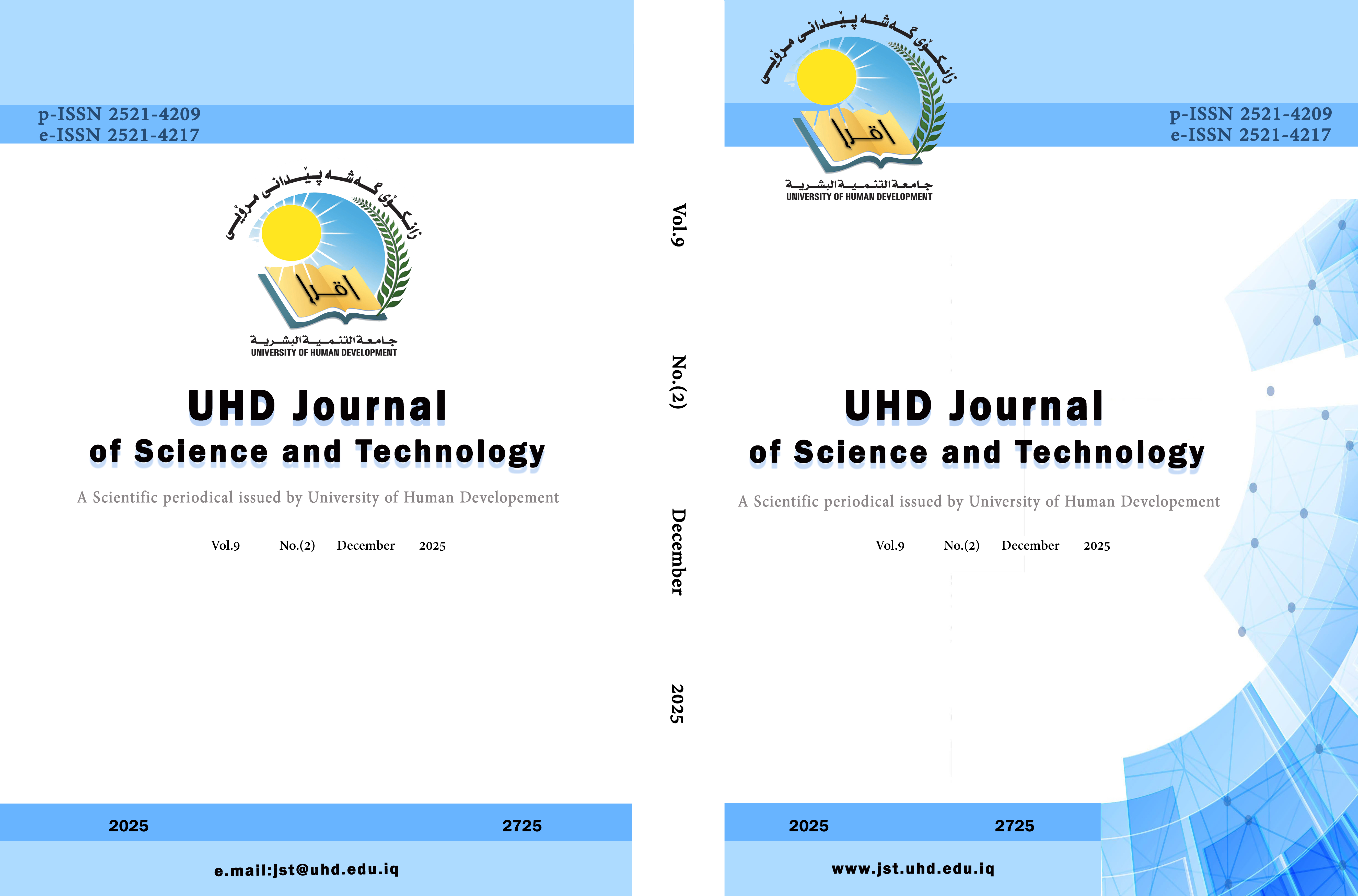Infant Mortality in Iraq and Iran: A Comparative and Predictive Study
DOI:
https://doi.org/10.21928/uhdjst.v9n2y2025.pp305-312Keywords:
Time Series, Exponential Grey Model, Infant MortalityAbstract
Infant mortality is one of the most important indicators of the A country’s health status and socio-economic development. Classified as the death of an infant before his or her first birthday, the rate of infant mortality is an indicator of whether a society has sufficient healthcare, nutrition, sanitation, and maternal services. The research presents comparative predictive analysis for Iraqi and Iranian infant mortality rates (IMR) during the period 2025–2032 with the help of exponential grey mod. These findings demonstrate a high effectiveness of the proposed aforementioned application with achieved mean absolute percentage error (MAPE) values of 0.795% and 0.907% for Iraq and Iran, respectively, which correspond to accuracy rates of 99.20% and 99.09%, both as both Iraq and Iran’s MAPE values in the “Highly accurate.” Corresponding precision values also classifies the decisions in “Highly accurate” (P ≥ 99.0%). A historical comparison showed a significant difference in infant mortality when comparing Iraq (mean = 27.37) with Iran (mean = 15.57) with P = 0.000. Projections for 2025–2032 also indicate a difference between the two nations, as a country average IMR in Iraq will be 18.32, and, it accounts for 8.41 for Iran, with statistical significance (P = 0.000). It also forecasts falls in the number of births, with Iraq’s dropping from 20.13 in 2025 to 16.61 in 2032, and Iran’s from 9.63 to 7.28. These results validate that the exponential grey mod model offers a superior forecasting model that has great stability and performance for these two countries (Iraq and Iran) to supply decision makers with high-quality forecasts.
References
World Health Organization (WHO). “Infant Mortality”, 2022. Available from: https://www.who.int/data/gho/indicator-metadata-registry/imr-details/61 [Last accessed on 2025 Jun 11].
United Nations Development Programme (UNDP). “Sustainable Development Goals”, 2023. https://www.undp.org/sustainable-development-goals
M. N. Moghadam, A. Aryankhesal and H. Haghparast-Bidgoli. “Reducing infant mortality in Iran: Successes, challenges, and the way forward”. International Journal of Health Policy and Management, vol. 10, no. 5, pp. 264-272, 2021.
T. K. Al Hilfi, R. Lafta and G. “Burnham. Health services in Iraq”. The Lancet, vol. 381, no. 9870, pp. 939-948, 2013.
G. E. Box, G. M. Jenkins, G. C. Reinsel and G. M. Ljung. “Time Series Analysis: Forecasting and Control”. 5th ed. Wiley, United States, 2016.
J. Deng. “Introduction to grey system theory”. The Journal of Grey System, vol. 1, no. 1, pp. 1-24, 1989.
S. Liu and Y. Lin. “Grey Systems: Theory and Applications”. Springer, Berlin, 2010.
World Bank. “The World Bank Provides Annual Estimates for the Infant Mortality Rate in Iraq”. In: Their Most Recent Data. World Bank, United States, 2023.
United Nations. “The Millennium Development Goals Report 2020”. UN Website, United Nations, 2020.
World Health Organization (WHO). “Infant Mortality”. WHO Fact Sheets, Geneva, 2021.
A. Khan, M. Ali and N. Siddiqui. “Improving maternal and child health in low-income settings: Key interventions”. The Lancet Global Health, vol. 8, no. 10, pp. e1265-e1272, 2020.
C. G. Victora, L. Adair, C. Fall, C. Hallal, P. R. Martorell and L. Richter. “Maternal and child undernutrition: Consequences for adult health and human capital”. The Lancet, vol. 371, no. 9609, pp. 340-357, 2016.
O. Lincetto, S. Mothebesoane-Anoh and A. Langer. “Maternal education and child survival in developing countries: A review of the evidence”. The Lancet, vol. 368, no. 9535, pp. 1817-1825, 2016.
R. E. Black, C. G. Victora, S. P. Walker, Z. A. Bhutta, P. Christian, M. De Onis, M. Ezzati, S. Grantham-McGregor, J. Katz, R. Martorell, R. Uauy and Maternal and Child Nutrition Study Group. “Maternal and child undernutrition and overweight in low-income and middle-income countries”. The Lancet, vol. 382, no. 9890, pp. 427-451, 2013.
H. Tappis, E. Munkhtsetseg and P. Waiswa. “Maternal health and infant mortality in East Asia: A review of trends and interventions”. BMC Health Services Research, vol. 20, no. 1, p. 123, 2020.
World Food Programme. “UN World Food Programme (WFP)”. World Food Programme, United States, 2020.
E. Ransom and P. Yoder. “The impact of water, sanitation, and hygiene on child health: A critical review of the literature”. Global Health Action, vol. 2, no. 1, pp. 1-7, 2009.
C. Troeger, I. A. Khalil, P. C. Rao, S. Cao, B. F. Blacker, T. Ahmed, G. Armah, J. E. Bines, T. G. Brewer, D. V. Colombara, G. Kang, B. D. Kirkpatrick, C. D. Kirkwood, J. M. Mwenda, U. D. Parashar, W. A. Petri Jr., M. S. Riddle, A. D. Steele, R. L. Thompson, J. L. Walson, J. W. Sanders, A. H. Mokdad, C. J. L. Murray, S. I. Hay and R. C. Reiner. “Rotavirus vaccination and the global burden of rotavirus diarrhea among children younger than 5 years”. JAMA Pediatr, vol.10, pp. 958-965, 2018.
S. K. Sahu, P. Sharma and A. Kumar. “Air pollution and its impact on public health: Emerging trends in India”. Environmental Monitoring and Assessment, vol. 190, no. 8, pp. 1-12, 2018.
R. E. Black, C. Levin, N. Walker, D. Chou, L. Liu, M. Temmerman and Disease Control Priorities Project. “Reproductive, maternal, newborn, and child health: Key messages from disease control priorities 3rd edition”. The Lancet, vol. 388, no. 10061, pp. 2811- 2824, 2017.
World Health Organization. “Infant Mortality”, 2023. Available from: https://www.who.int/news/room/fact-sheets/detail/infant-mortality
Downloads
Published
How to Cite
Issue
Section
License
Copyright (c) 2025 Banw Azad Mohammed Ali, Awat Hassan Azeez, Soran Husen Mohamad

This work is licensed under a Creative Commons Attribution-NonCommercial-NoDerivatives 4.0 International License.



